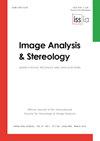脑胶质瘤磁共振图像分割的Pu-net深度学习架构
IF 1
4区 计算机科学
Q4 IMAGING SCIENCE & PHOTOGRAPHIC TECHNOLOGY
引用次数: 0
摘要
医学图像的自动分割是许多器官和病理结构描绘的主要任务之一。它也是脑肿瘤后临床检查的关键技术,如应用放射治疗或肿瘤限制。各种图像分割技术已经被提出并应用于不同的图像类型。最近,研究表明,深度学习方法可以准确地分割图像,并且其实现通常很简单。在本文中,我们提出了一种基于深度学习的多模态磁共振图像(MRI)自动脑肿瘤分割的新方法,称为PU-net。我们将输入处理块引入自定义的全卷积网络,该网络源自U-Net网络,用于处理多模态输入。我们在2018年收集的Brats脑肿瘤数据集上进行了实验,在整个肿瘤(WT)、肿瘤核心(TC)和增强肿瘤(ET)类别上分别获得了0.905、0.827和0.803的骰子分数。与传统的机器学习方法(如支持向量机(SVM)、随机森林(RF)和在此背景下使用的其他深度学习方法)相比,本研究也提供了有希望的结果。本文章由计算机程序翻译,如有差异,请以英文原文为准。
PU-NET DEEP LEARNING ARCHITECTURE FOR GLIOMAS BRAIN TUMOUR SEGMENTATION IN MAGNETIC RESONANCE IMAGES
Automatic medical image segmentation is one of the main tasks for many organs and pathology structure delineation. It is also a crucial technique in the posterior clinical examination of brain tumours, like applying radiotherapy or tumour restrictions. Various image segmentation techniques have been proposed and applied to different image types of images. Recently, it has been shown that the deep learning approach accurately segments images, and its implementation is usually straightforward. In this paper, we proposed a novel approach, called PU-net, for automatic brain tumour segmentation in multi-modal magnetic resonance images (MRI) based on deep learning. We introduced an input processing block to a customised fully convolutional network derived from the U-Net network to handle the multi-modal inputs. We performed experiments over the Brats brain tumour dataset collected in 2018 and achieved dice scores of 0.905,0.827, and 0.803 for the whole tumour (WT), tumour core (TC), and enhancing tumour (ET) classes, respectively. This study also provides promising results compared to the traditional machine learning methods, such as support vector machines (SVM), random forest (RF) and other deep learning methods used in this context.
求助全文
通过发布文献求助,成功后即可免费获取论文全文。
去求助
来源期刊

Image Analysis & Stereology
MATERIALS SCIENCE, MULTIDISCIPLINARY-MATHEMATICS, APPLIED
CiteScore
2.00
自引率
0.00%
发文量
7
审稿时长
>12 weeks
期刊介绍:
Image Analysis and Stereology is the official journal of the International Society for Stereology & Image Analysis. It promotes the exchange of scientific, technical, organizational and other information on the quantitative analysis of data having a geometrical structure, including stereology, differential geometry, image analysis, image processing, mathematical morphology, stochastic geometry, statistics, pattern recognition, and related topics. The fields of application are not restricted and range from biomedicine, materials sciences and physics to geology and geography.
 求助内容:
求助内容: 应助结果提醒方式:
应助结果提醒方式:


